North Yorkshire Heritage Coast
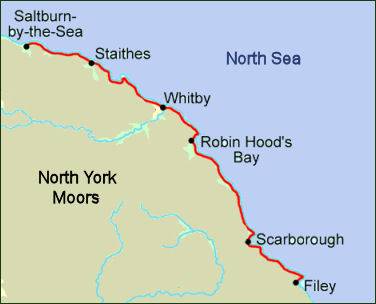
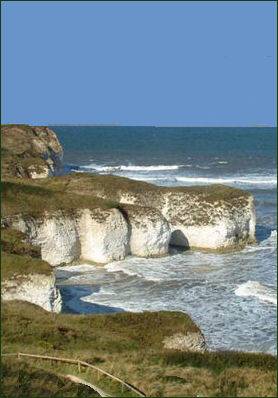 The North Yorkshire Heritage Coast runs the entire length of the scenic North York Moors National Park, from Filey up to the Victorian seaside resort town of Saltburn. The coastline is a dramatic, with its high rugged cliffs dotted and small characterful fishing villages.
The North Yorkshire Heritage Coast runs the entire length of the scenic North York Moors National Park, from Filey up to the Victorian seaside resort town of Saltburn. The coastline is a dramatic, with its high rugged cliffs dotted and small characterful fishing villages.
The Cleveland Way National Trail runs the entire length of the heritage coast, the 109 mile (175 Km ) long walking route passes through beautiful and ever changing landscapes, starting at Helmsley in the North York Moors it and ends on the long narrow peninsula of Filey Brigg.
Whitby is the cultural centre of the heritage coast, set in a deep ravine at the mouth of the River Esk, it is one of North-east Yorkshire's most popular seaside towns and has much to offer the visitor. With its narrow cobbled lanes and streets leading to a the busy, characterful harbour, fishing trawlers sailing past, lifeboat cruises, and pubs jostling for position alongside lively bars, Whitby is a town of endless charm and surprising contrasts. the harbour has small shops filled with crafts, curios, and antiques. It was from here that the eighteenth century explorer and voyager Captain James Cook (1728-1779) set sail in the Bark Endeavour.
Whitby's skyline is dominated by the haunting ruins of Whitby Abbey, standing stark against the skyline high on on the East Cliff. The abbey was founded in 651 A.D., by Oswy, king of Northumbria (circa 612 - 15 February 670), a devoted Christian, who promoted the faith among his subjects and establishing a number of monasteries. He had defeated a pagan opponent, Penda, in battle two years prior to founding Whitby Abbey. Oswy appointed Hilda (circa 614-680), the abbess of Hartlepool Abbey, as its first abbess. The parish church of Whitby, St. Mary's, stands in a dramatic position high on Whitby's East Cliff, from where it overlooks the town and the mouth of the River Esk below. A flight of 199 steps lead up the hill to the church and Whitby Abbey from the streets below. The church was founded in Norman times but has been much altered since then.
The small coastal village of Ravenscar is set in a dramatic clifftop location and is situated around 10 miles (16 km) to the north of the popular seaside resort of Scarborough. Until the early twentieth century the village was known as Peak. In the Edwardian era, there were plans to turn the village into a holiday resort to rival nearby Scarborough. Roads were built and some houses were constructed. However due to the long walk to its rocky beach, Ravenscar never achieved popularity, and the development was never completed leading Ravenscar to be referred to as 'the town that never was'.
The small picturesque fishing village of Robin Hood's Bay lies five miles to the south of Whitby. The village is situated at the eastern end of Alfred Wainwright's famous 190-mile Coast to Coast Walk, and is also a popular stopping-off point for those walking the Cleveland Way. Situated about a mile to the south of Robin Hood’s Bay along the ‘Cleveland Way’ Long Distance Footpath, Boggle Hole, is one of the Yorkshire Coast's little known, hidden gems. It consists of a sheltered bay in front of the old converted Watermill, now a youth hostel and was once a notorious smugglers’ haunt. The clifftop path affords stunning views of Robin Hood’s Bay, which sweeps in a graceful curve from the promontory of North Cheek, also called Ness Point, to South Cheek or The Old Peak.
Dramatic Flamborough Head (right) with its gleaming white chalk cliffs which drop sheer into the North Sea, is situated between the Filey and Bridlington bays. The cliffs at Flamborough Head are designated a Site of Special Scientific Interest for both geological and biological significance. he headland is one of the most spectacular areas of chalk cliffs in Britain, it is is 8 miles (13 km) long, as well as its distinctive white cliffs, there are coves, sea caves and stacks along the coastline.
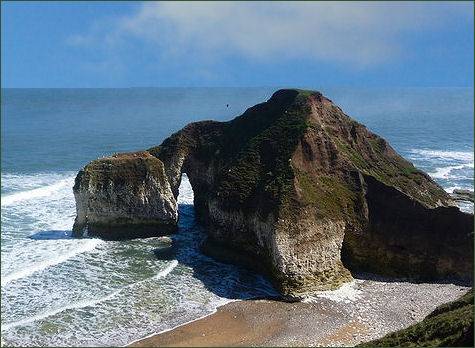 Flamborough Head has two standing lighthouse towers on its cliffs, the oldest dating from 1669 and Flamborough Head Lighthouse which was built in 1806. The lighthouse was built by John Matson of Bridlington and is 85 feet tall. The lamp mechanism rotates constantly on a bed of mercury.
Flamborough Head has two standing lighthouse towers on its cliffs, the oldest dating from 1669 and Flamborough Head Lighthouse which was built in 1806. The lighthouse was built by John Matson of Bridlington and is 85 feet tall. The lamp mechanism rotates constantly on a bed of mercury.
Stunning Bempton Cliffs, which lie on the north side of Flamborough Head, has an RSPB reserve and visitor centre which provides guided walks of the area. From April to August, the cliffs are alive with nest-building adults or young chicks. Bempton Cliffs stretch for about 6 miles (10 km) from Flamborough Head northwards towards Filey and soar to over 100 metres (330 feet) high in places. The hard chalk cliffs at Bempton rise are relatively resistant to erosion and offer lots of sheltered headlands and crevices for nesting birds. One of Britain's top wildlife spectacles and the most accessible seabird colony in the United Kingdom. Over a quarter-of-a-million seabirds swooping, soaring and screech around the towering chalk cliffs. Between March and October, visitors can see puffins, guillemots, razorbills, kittiwakes, herring gulls, fulmars and shags here as well as the largest seabird in Britain, the gannet.
The village of Flamborough stands on the prominent headland. The village lies around 4 miles (6 km) to the north-east of the popular coastal resort town of Bridlington. Flamborough village is thought to have been originally settled over 1,100 years ago by Vikings, it is mentioned as "Fleneburg" in the Domesday Survey of 1086. The village is cut off by the enormous defensive earthwork of Danes Dyke which was dug in the Iron Age and divides the Flamborough Head peninsula from the mainland. The Dyke runs for 4km (about 2.5 miles) from the Danes Dyke Nature Reserve in the south to Cat Nab on the Bempton Cliffs in the north.
The characterful coastal village of Staithes, with its narrow winding streets has a sheltered harbour, bounded by high rugged cliffs of Penny Nab, Cowbar Nab, and Bias Scar and has two long breakwaters. Nowadays, the boats are used by local fishermen to catch cod, lobsters and crabs and short pleasure cruises are available. The small beach has a cluster of rock pools. The old town features stone fishermen's cottages and town houses, which huddle around alleys and flights of steps. Staithes's most famous resident, the eighteenth century explorer Captain James Cook (1728 -1779) was born in Marton near Middlesbrough, but lived at the village from 1745 to 46, where he worked as a grocer's apprentice to William Sanderson. Staithes is where he first felt the lure of the sea while gazing out of the shop window. Later, having been introduced to friends of Sanderson's, John and Henry Walker, local ship-owners, he moved to nearby Whitby where he joined the Royal Navy.
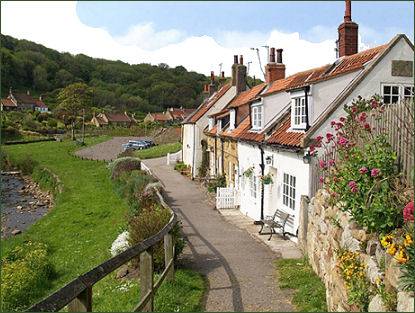 The equally attractive old fishing village of Runswick Bay boasts much charm.The village is situated 8 miles to the north of of Whitby.The village's red-roofed cottages huddle on the northern end of a sweeping bay facing the North Sea. It has a mile long sandy beach and is very popular with holidaymakers. In the cliffs of Runswick Bay there are small caves called Hob Holes, formed by the action of the waves, and completely submerged at high tide. A hob is a creature from the folklore of the north of England. Hob Holes is reputed to be the haunt of a goblin, Hob. This hob was said to be unusual in that it was thought to be able to cure whooping cough, local parents would bring their afflicted child to the cave and recite a rhyme in the hope of a cure.
The equally attractive old fishing village of Runswick Bay boasts much charm.The village is situated 8 miles to the north of of Whitby.The village's red-roofed cottages huddle on the northern end of a sweeping bay facing the North Sea. It has a mile long sandy beach and is very popular with holidaymakers. In the cliffs of Runswick Bay there are small caves called Hob Holes, formed by the action of the waves, and completely submerged at high tide. A hob is a creature from the folklore of the north of England. Hob Holes is reputed to be the haunt of a goblin, Hob. This hob was said to be unusual in that it was thought to be able to cure whooping cough, local parents would bring their afflicted child to the cave and recite a rhyme in the hope of a cure.
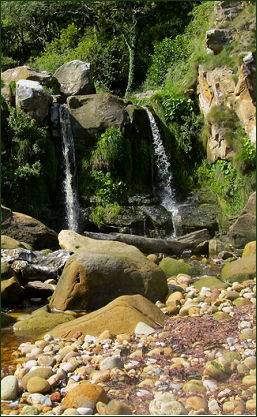 Runswick Bay has a peaceful sandy beach which is sheltered from the northern gales by Lingrow Knowle, the lofty crag which towers above the bay. Fossils abound on the beach, ammonites particularly are locked into the small scattered ironstone pebbles. Brachiopods, marine animals similar to clams can also be found. The fossil remains of a Plesiosaurus, esitmated to be 180 million years old and an Ichthyosaurus, a large predator which was similar to a dolphin in shape, were found here a century ago and are now on display at Whitby Museum.
Runswick Bay has a peaceful sandy beach which is sheltered from the northern gales by Lingrow Knowle, the lofty crag which towers above the bay. Fossils abound on the beach, ammonites particularly are locked into the small scattered ironstone pebbles. Brachiopods, marine animals similar to clams can also be found. The fossil remains of a Plesiosaurus, esitmated to be 180 million years old and an Ichthyosaurus, a large predator which was similar to a dolphin in shape, were found here a century ago and are now on display at Whitby Museum.
The picture postcard coastal village of Sandsend (left) is situated 2 miles to the north of Whitby, nestling under Lythe Bank and Mulgrave Woods, the village stretches along a sweep of beach, and is divided by a stream running into the sea. It provides clear views of the imposing ruins of Whitby Abbey. The award winning sandy beach extends toward Whitby and has fossil-rich rock pools, reptile remains have been found on the foreshore, along with many ammonites and shells. The beach is also ideal for sea angling as well as surfing. There is a popular beach walk to nearby Whitby or along the sand and rocks to Kettleness where there are caves. There are also some stunning walks along the cliffs.
Hayburn Wyke is a lovely secluded cove and lies between the bustling coastal towns of Scarborough and Whitby. The peaceful beach is backed by woodland and makes a perfect spot for a picnic. A delightful double waterfall flows directly onto the rock and pebble, seaweed strewn beach with its pools and crevices.
The Yorkshire coastline contains some of the worlds best Jurassic and Cretaceous geology leading to it being given the nickname of the Dinosaur Coast.Fossils can easily be found on the beaches at Whitby, Staithes and Runswick Bay with Britain's oldest dinosaur bone being found on Whitby beach. The bone fell out of a cliff face and after detailed analysis was found to be 176 million years old.
The views from the cliffs around Kettleness are stunning on a clear day, both northwards towards Runswick Bay, and to the south east, over the coast towards Whitby with haunting Whitby Abbey, the inspiration for Brahm Stoker's 'Dracula', standing spectre like on its headland. Kettleness is well known amongst fossil hunters and is one of the most productive locations on the Yorkshire coast. Dinosaur bones and ammonites are regularly found along the foreshore and in the cliff. It is the most productive location in Yorkshire for reptile remains, a Pliosaur, an extinct marine reptile and the fossilised remains of an Ichthyosaur have both been discovered there. The ammonites of the area are similar to those from Port Mulgrave. They can often be found in the cliff, within the scree at the base of the cliff or within piles of shale exposed on the beach.
